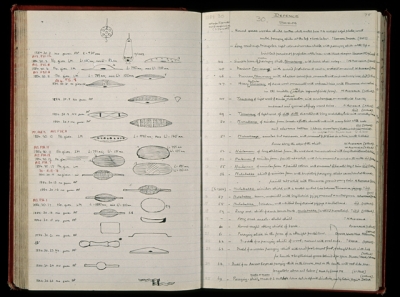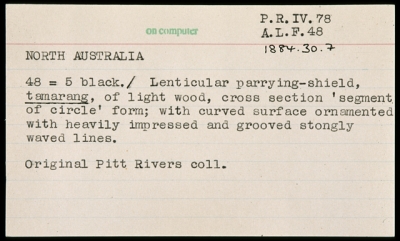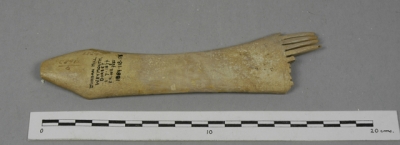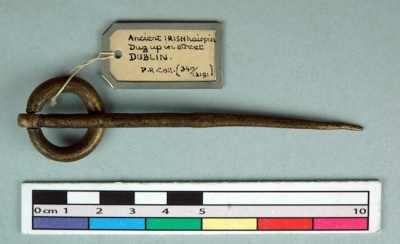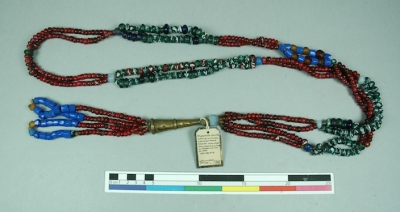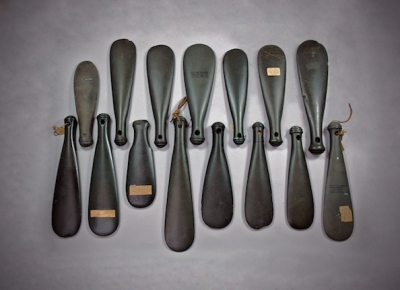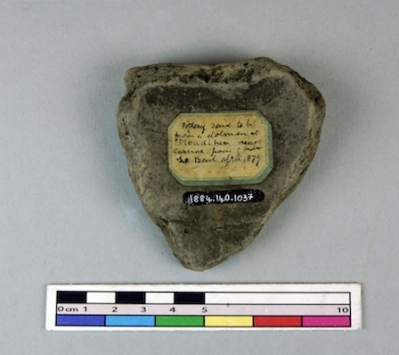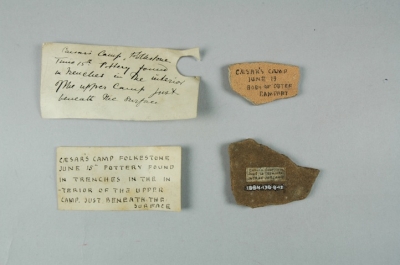To search the RPR site click here
The founding collection objects have been cared for by two museums in their history: first the South Kensington Museum authorities (who also cared for the Bethnal Green collections) from 1874-circa 1886 and the Pitt Rivers Museum at Oxford from 1886. In the nineteenth century museums collections management methodology was not fixed but still being worked out.
Before 1874
As he probably owned many thousands of objects by the 1860s it seems likely he must have had some system of keeping track where objects were and what they were but, if they were, the details have never been confirmed.
South Kensington Museum must have had museum procedures in place by the 1870s but it is not clear from the founding collection what they were. They certainly recorded all the items that they received from Pitt-Rivers in their 'day book', a copy of which is held by the Pitt Rivers Museum where it is most often referred to as the 'Green book'. A second copy is held as part of the Salisbury and South Wiltshire Museum Pitt-Rivers papers [P116]. This book briefly recorded the details of all the objects received from a particular donor in one day (hence its name). In addition they appeared to have also completed partial lists of items in the founding collection at South Kensington Museum during the 1870s in the so-called blue, red and black books (which were covered with covers of those colours at one time).
In 1874 Pitt-Rivers (or Lane Fox, as he was then known) published a catalogue of part of his collection as a sort of guide to the displays of his collection at Bethnal Green and (after 1878) at the main South Kensington Museum site. This was very partial, as he did not complete it, and the published volume only covers some weaponry and a few physical anthropology specimens. A page from this catalogue is shown here. However, it does appear to have been designed to direct the museum visitor around his displays rather than a formal museum catalogue.
One thing that was done whilst the founding collection was at South Kensington Museum was to assign some unique numbers to the objects. On many (but not all) objects can be found a one to four figure number, or a fraction number. The earlier one to four figure numbers relate to items listed in Pitt-Rivers catalogue published in 1874, for example '592' relates to 1884.13.31, a staff-spear from New Zealand described by its owner in 1874 as 'Screen 19 ... 592 593 Spears of red wood 6ft 4 in and 5ft 10in in length, pointed, and 3/4 in and 1in in diameter. Australia.' [1874/8: 106] Later a complicated system was instituted, the logic of which is hard to understand. This system meant that fraction numbers were given to objects loaned by Pitt-Rivers between 1874 and 1884 (after the initial loan in 1874). '82/ 9680' for example is the number associated with an object that is now numbered 1884.2.1 and described as 'Locks and Keys Late Celtic sickle-like iron key Jordan Hill, Weymouth Medhurst coll.' There does appear to be a relation between the one to four figure numbers used in the printed catalogue and the fraction numbers because the four figure numbers stop just before the fraction numbers begins around 9974. Beatrice Blackwood called the one to four figure numbers, Ag or Aggregate numbers, which does suggest that they mark a progression from one object to many.[1] To find out more about this system and other earlier aspects of museum documentation of the founding collection go here.
It is hard to know what labels attached to founding collection items date from before 1885 (that is, from their time at Bethnal Green Museum). However, it is clear that the label shown here dates from then (or even from before Bethnal Green) as it reflects precisely what Lane Fox had said, and published, about the object in particular, which is one of a series of paddles discussed in much more detail here.
After 1884, at Oxford
At first the Pitt Rivers Museum was really a sub-department of the much larger Oxford University Museum which had been founded some twenty years earlier. It must be presumed that, at first (at least), the Museum followed the established practices of other departments within the University Museum. However, they do not appear to have been very rigorous. There were some half-hearted attempts to record some items from the founding collection into various notebooks but the first systematic accession registers for the founding collection were not prepared until the 1920s when three volumes were compiled by Ernest Seymour Thomas, an assistant to Balfour. A page from one of these volumes can be seen here. You can see that relatively little information was noted for each object. At this stage the museum had not yet assigned unique numbers to each object.
However, before the 1920s some documentation was carried out as many objects from the founding collection are marked, in ink upon their surface, with copious details of their geographical provenance and use. It is possible that some of these handwritten accounts may have been written on the objects whilst they were in the care of the South Kensington Museum. Only the size of the object appears to have affected the length of written text with many objects having between 5 and 10 words crammed on them, and some have considerably more. Only the very smallest objects were not treated in this way. The ink that was used for these markings seems to have been particularly 'permanent' and these descriptions are still very clearly legible today. See the bottom of this page for an example.
Museum staff also carried out another method of associating objects with their data, they hand-wrote cardboard labels edged with metal which were firmly tied to the objects. These are very small but can contain a great deal of information. More information about museum labels and photographs showing examples can be found at the bottom of this page.
Another form of early museum documentation was the index card catalogue. Such card catalogues allowed arrangement (and re-arrangement) of the cards for each object into series, so that like objects could be found easily. At the beginning in the 1920s a series of subject catalogues began to be compiled under Henry Balfour's management, mostly by volunteers like Francis Knowles, on subjects like smoking appliances, and shoes. These included items from the founding collection.
From the late 1930s a comprehensive series of catalogue cards were produced, one for each object in the Pitt Rivers Museum's collections, including those from the founding collection. Each object had two cards prepared for it, one which was sorted by geographical or cultural provenance (so all objects from England, for example, could be found together, or all objects from the Zulu nation) and the other by type of object (weapons, fans, fire accessories for examples). A sample card showing the kinds of information that was kept are shown here. By and large the cards duplicate the information from the accession registers, but make it easier to retrieve the details for a specific object.
At the same time that the catalogue card systems were established the Museum, for the first time, assigned unique accession numbers to each object that was accessioned. The founding collection numbers were assigned retrospectively using the accession books as the guide. For this reason the founding collection accession numbers are different from other Pitt Rivers Museum accession numbers. In most instances the museum numbers are divided into three sections, the year that the object was accessioned [2010], the number of collections since the beginning of the year [the third collection], and the number of objects that has been reached in that collection [say, the eighth] - this would give a number of 2010.3.8. The founding collection numbers, however, are all assigned the year 1884 (when the gift of the collection was formally accepted by the University), the next subdivision marks the class or display to which the object was assigned (for example Weapons: Spears) and the next the number of objects within that sub-section. These numbers, however, were not physically written onto the objects and this task has had to be undertaken by museum staff ever since.
Now all these sources have been transcribed onto the computer entries which have been prepared for each object in the founding collection. These will be available on this site and are already available here.
Types of documentation
Written on the objects
Many Pitt-Rivers' objects have a large amount of information either handwritten directly onto them in black or white ink, or else written or printed onto paper labels which are stuck onto the objects. This information can be several lines long. It is not known whether these sorts of information were added by the Museum at Oxford or date from before 1884. Certainly the Pitt Rivers Museum did write directly onto object short descriptions like 'Factory site, above NAHUN R. (L. bank) nr. E. LONDON, S. AFRICA. d.d. H. Balfour, 1910', which was written onto a brown quartzite tool [1910.36.27]. However, some of the Pitt-Rivers' written descriptions are so long and discursive that it would appear that they were display aides and probably associated with the objects from before 1884. You can see here an example of a shorter written description on an object.
Glued to the objects
Often the Museum would also glue longer labels to objects, especially if the object was large enough to provide space to do so. This would make writing much more straightforward as the label was always white / cream and black ink showed well against the background. It is not known what form of adhesive was used but it was extremely effective as very few of these labels have come unstuck. Today, marking the surface of an object in this way would not be acceptable museum practise.
Tied to the objects
The Pitt Rivers Museum today uses inert plastic, purpose-made, museum labels which are standard issue to museums throughout the UK. These have a surface upon which documentation data can be hand-written in ink with a rotring pen and a plastic cover to protect the writing. The labels are attached using unbleached cotton thread. Earlier in the museum's history the museum also used purpose made labels but these were made from cardboard and edged with metal. Again they were written in ink but the handwriting was exceptionally neat and legible so that the labels could also serve as display labels (that is, tell the museum visitor what the object was and what it was used for, and who donated it). These were attached with unbleached ?linen thread. Today many objects on display in the Museum have specifically designed and written display labels which are not attached to the object as well as the smaller and shorter labels attached to them. Examples of all the labels mentioned above are shown below
Find out more about the documentation of the founding collection here.
AP, August 2010, updated September 2010, updated regarding Ag numbers in March 2011
Notes
[1] Interestingly, however, the so-called 'Black book' (whose entries were written before 1885 at Bethnal Green and South Kensington Museums) suggests that 'Ag' actually stood for 'Agenda'.

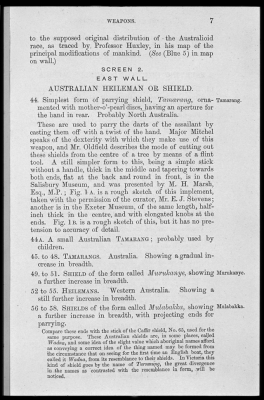
![A typical pre-1884 label [1884.61.29]](../../component/joomgallery/1884_61_29_label_2_20110125_1141750497-view=image&format=raw&type=img&id=508&Itemid=41.jpg)
